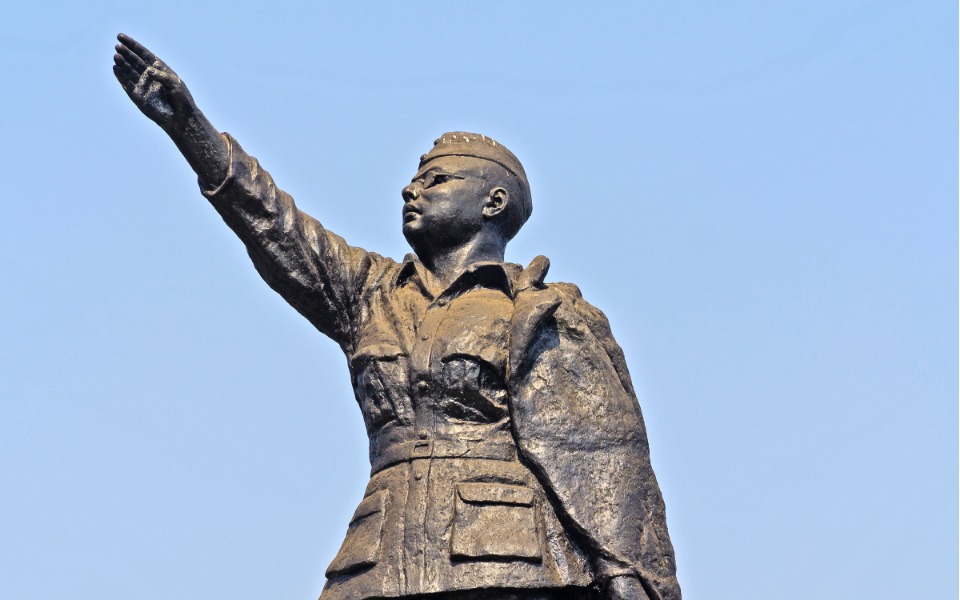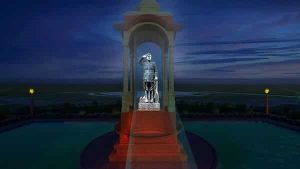
The symbolism of statues in Modi's new India

Let us begin with an elementary question: What purpose do statues serve?
This question assumes importance in the background of media and public hype over Prime Minister Narendra Modi’s unforeseen move on installing Netaji Subhash Chandra Bose’s statue beneath the vacant canopy adjacent to India Gate. This site remained unoccupied for more than half a century, a period marked by extensive democratic, at times even acrimonious, debate over whether and which statue of Mahatma Gandhi should be installed under the imperial chhatri, or if it must remain as a symbolic emptiness to mark the passage of the colonial era. In contrast, Modi’s announcement was not preceded by deliberations outside the government, a sign that ‘decisive’ leadership is effectively synonymous with non-consensual decision-making processes.

Inaugurals and unveiling of artefacts in India are seldom unaccompanied by politically-laced speeches, especially if the honours are performed by Modi. The points he made, reflected his consistent efforts to vocalise a new response to history. Simultaneously, he blamed predecessors, no second guesses on the identity of who ‘she, he or they’ were, for “attempts made to erase the contribution of many great personalities along with the culture and ethos of the country.”
The Prime Minister picked up kudos for himself by asserting that “after decades of independence, the country is correcting those mistakes.” Union Home Minister Amit Shah too thanked him for enabling citizens to “find peace” and for having “honoured Netaji’s contribution in the freedom struggle of the country after so many years”.
The Prime Minister’s initiative cannot be seen solely from the prism of raising statues at his initiative, most famously the Statue of Unity, the tallest in the world, to lionise Sardar Vallabhai Patel and herald a ‘new iconography’ for India. Modi’s penchant to etch his name, literally or figuratively, on plaques affixed on gigantic architectural signatures of his regime, has to be seen in continuum with monuments, new constructions and reworking of symbolic public spaces being undertaken since he assumed office.
Also read: Netaji kin unhappy with statue, many details of death
Globally, monuments, statues and parks embody politics of the regime of the moment. Over time, several of these sites evolved into terrains on which political battles were fought and in extreme cases, resulted in their raising or destruction. History is littered with abundant instances of obliteration of iconic statues and other structures especially after a new political order was established.
Raising new monuments in memory, or to deify, past rulers, martyrs for national causes, fallen soldiers or officials, is aimed at emphasising different interpretations of the past, although this may not always be unquestionable, as Modi’s latest move is. But, constructing any of these is considered the highest honour that can be given to a person, an idea that the person stood for, or even for an episode in history – Jallianwala Bagh in Amritsar for instance, although its makeover last year converted it into a veritable film set erasing its value as a stark reminder to a horrific colonial massacre.
Makeover of such public spaces, or of the canopied edifice on which Bose’s hologram statue is now lit before the statue in stone takes its now ordained place, underscores the change wrought by the current political dispensation. Quite like the new political vocabulary that has gradually acquired legitimacy and acceptance post-2014, architectural initiatives of the Modi regime are not just symbolic of a new polity but also the new ‘normal’.
By declaring itself as de facto ‘corrector’ of history, this regime has underscored the importance it places on history and on symbolic assertion of a ‘genuine’ past, as against a ‘pseudo’ or ‘humiliating’ past. William Faulkner famously wrote that the “past is never dead. It is not even past.” As a consequence, the past in India, will always live, the moot point being how it is understood or made to understand.
It was consequently necessary for Modi to publicly showcase his interpretation of history and ensure its public ‘acceptance’ by weaving new narratives to ‘justify’ the action, a process that entailed fanning victimhood – in this case that Netaji was conspiratorially ‘neglected’ by post-independence national leaders. From when he first unveiled his idea of the Statue of Unity in 2010, to mark what else but the beginning of the tenth year of his Chief Ministerial tenure, the Prime Minister emphasised ‘ignored’ elements of history while simultaneously de-emphasising the previously highlighted narratives of India’s past.
In India, like in almost every colonised nation, the practise of raising statues of rulers, leaders and officials dates back to the British era starting with the 19th century. The first colonial statue, of Governor-General Lord Cornwallis, was shipped to the Indian subcontinent in 1800. It is estimated that by 1927, when New Delhi was being ‘prepared’ as Imperial India’s architectural symbol, almost 170 statues of British monarchs and officials were installed within the country. More continued till 1947.
In the new capital where the British Monarch and Emperor of India, King George V presided over his imperial Durbar in 1911, to mark the capital shift from Calcutta, the Central Vista represented the primary pathway in this “new temple of the empire”. It had the Viceroy’s House and the All India War Memorial at the two extremities. Close to the India Gate, three years after the King died in 1936, Edward Lutyens, the chosen architect, designed a monument to deify the deceased emperor.
The resurrection by Modi of this once-forgotten name while undertaking the ‘new’ Central Vista project – on what was universally known as Rajpath since the late 1950s — is not strange because like almost a century ago, this stretch of road is now projected as the ‘new temple’ for New India, quite like New Delhi and Netaji’s statue is integral to the new national iconography.
It is possibly not just divine coincidence that the foundation stone of a new parliament building was laid by Modi in December 2020 – almost a hundred years after Prince Arthur, Britain’s Duke of Connaught and Strathearn, as the British Crown’s representative, laid the foundation for soon-to-become ‘old’ Parliament House.
Taking a page out of colonial statuary, this regime too has moved to dominate public spaces to demonstrate its ‘majority’ (read absolute power) with unbridled attempt to alter ‘what’ is the ‘nation’s history’ and in this manner foster public memory that bolsters the regime’s politics. The insistence and related controversy surrounding the Vivekananda statue in the capital’s Jawaharlal Nehru University being an instance of spatial assertion by the Centre.
This is not the first time that regimes in India have taken recourse to such devices to mark its presence on vision and memory. Statues of Dravidian icons, those part of the communist lore, the neo-Dalit iconography, and those of region-specific local heroic characters have been installed and at times torn down as witnessed in recent years in Tripura, West Bengal and Tamil Nadu.
This regime’s statuary politics, not restricted to raising statues, memorials, monuments parks and other public spaces, is intrinsically part of its ‘alternate’ history project. It is bolstered by Modi’s powerful oratory which ensures audible memory being imprinted as his speeches are incessantly relayed by a pliant audio-visual media and multiple social media platforms that enable on-demand playback options for people.
History testifies to the line between pursuit of politics of statues and self-aggrandisement being very thin. In recent memory, Mayawati outperformed adversaries in this act as Uttar Pradesh chief minister in 2007-2012. Although yet to assume national proportions, but temples to Modi have come up, either exclusively for him, or where rituals are performed to his bust. A double the life-size statue of him, sponsored by a party corporator, is also coming up in Bengaluru. Time will determine if these remain one-off instances, or if this regime’s statue politics gets focused in creating permanence for Modi’s visage in the future.
(The writer is a NCR-based author and journalist. His latest book is The Demolition and the Verdict: Ayodhya and the Project to Reconfigure India. His other books include The RSS: Icons of the Indian Right and Narendra Modi: The Man, The Times. He tweets at @NilanjanUdwin)
(The Federal seeks to present views and opinions from all sides of the spectrum. The information, ideas or opinions in the articles are of the author and do not necessarily reflect the views of The Federal)

